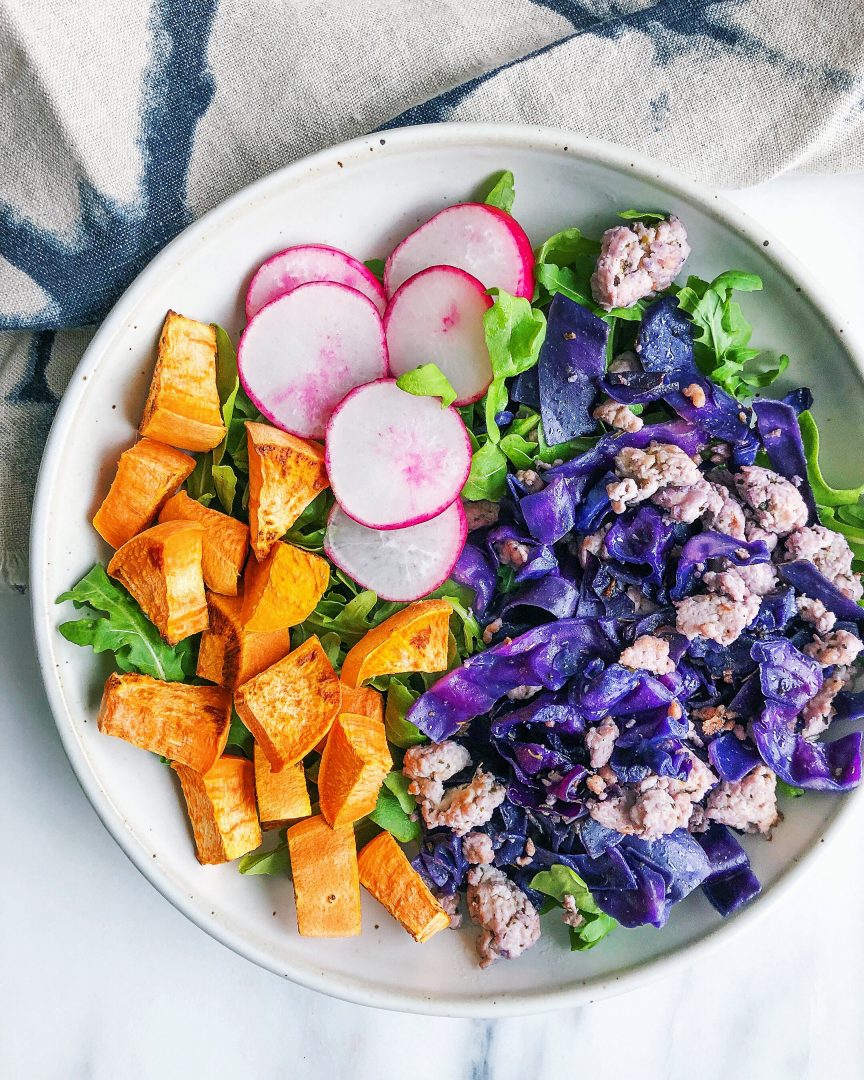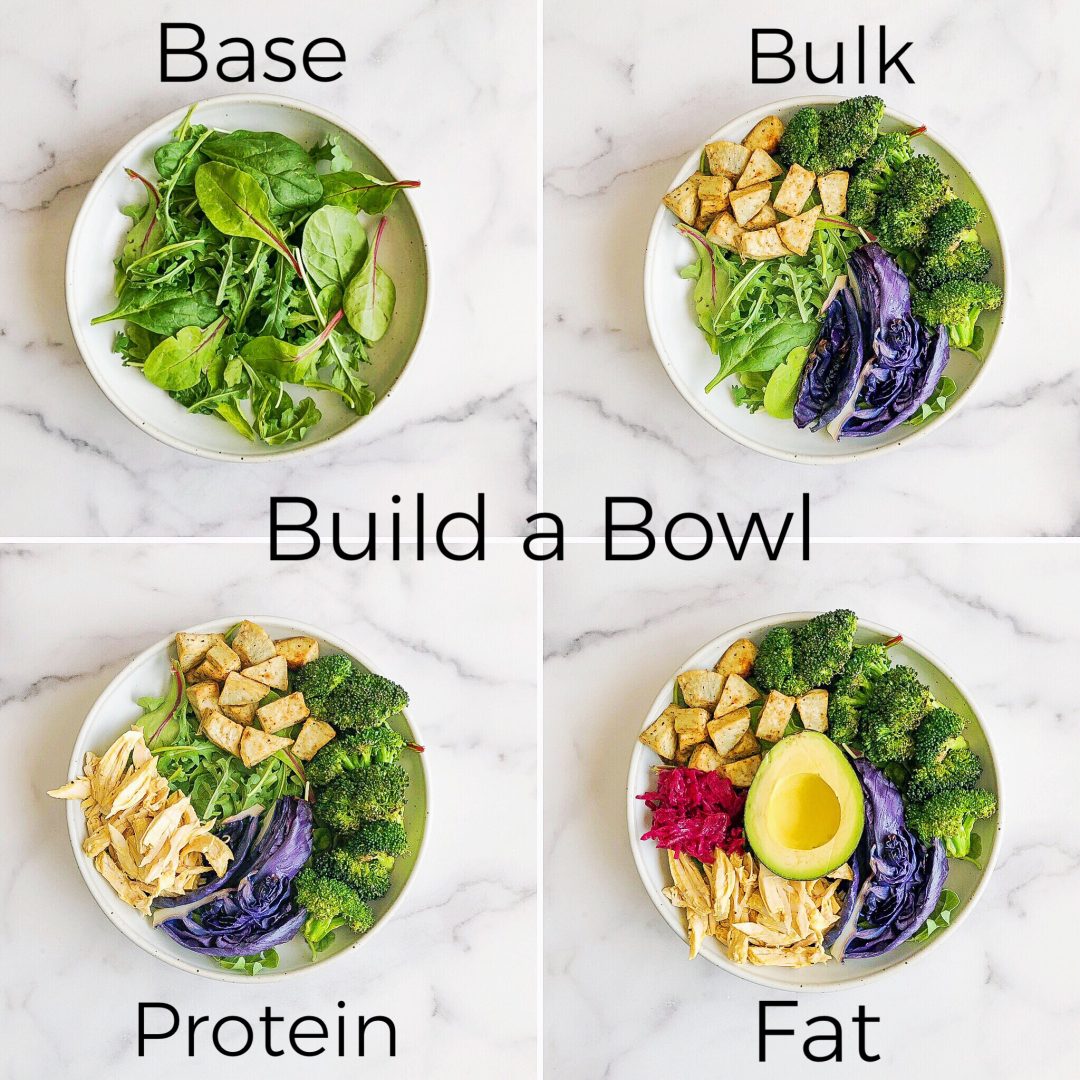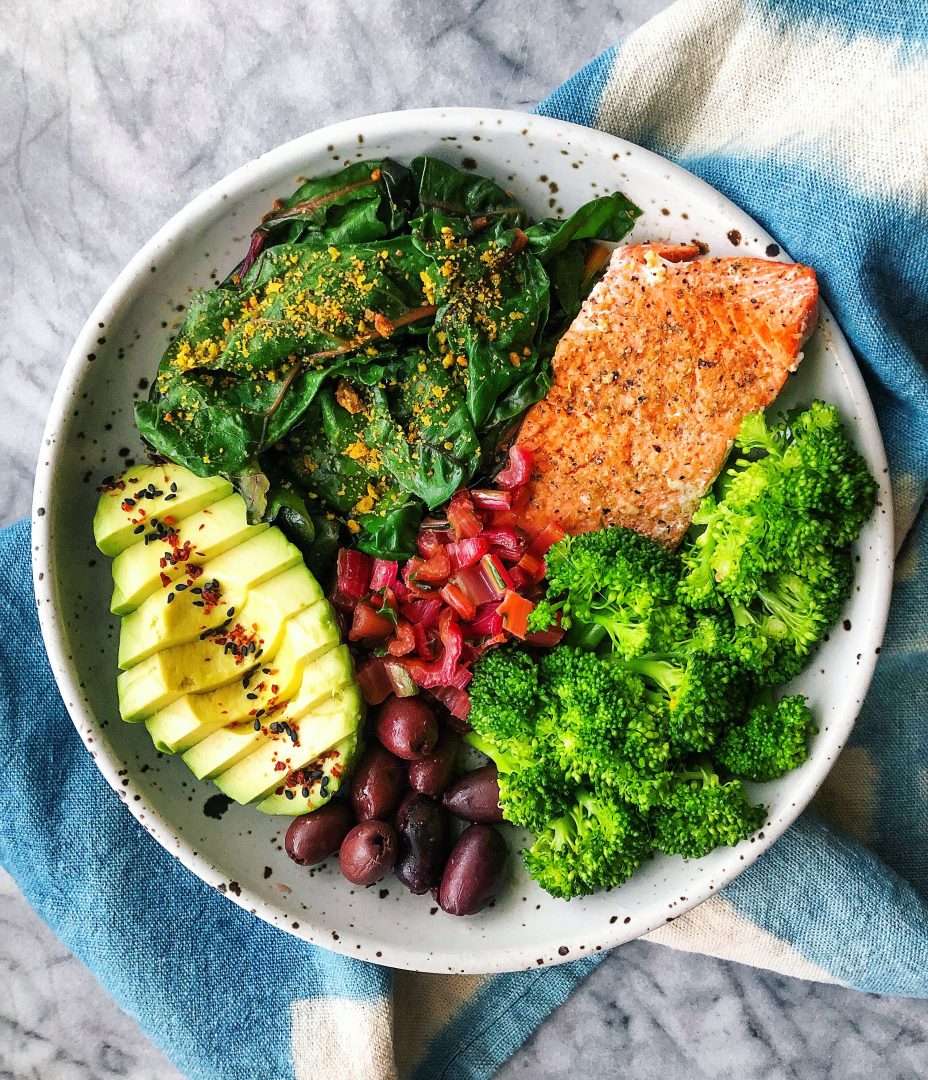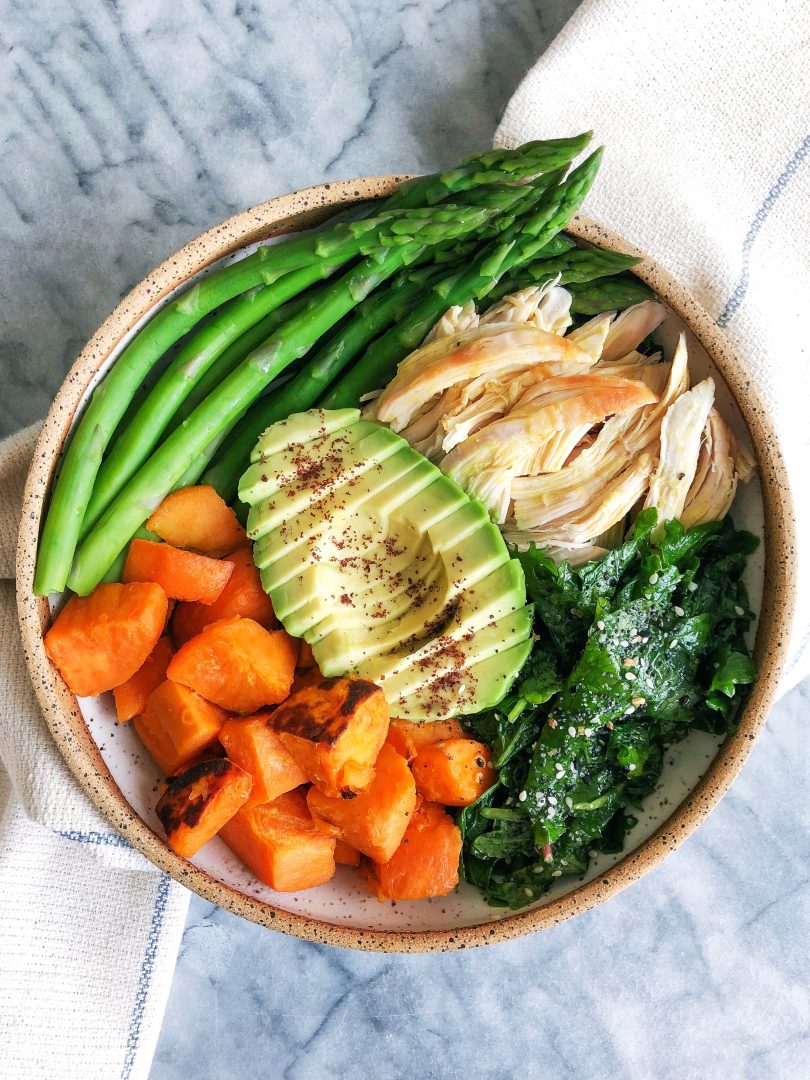Healthy Eating Simplified:
With all of the conflicting information on nutrition and diet, it’s easy to feel confused when it comes to healthy eating. But don’t worry, I’m here to help you eat like a nutrition expert. If you follow my step-by-step formula, putting together nutritious, satisfying meals can be easy. The most important thing you can do when it comes to nutrition is “get back to basics” and ditch highly-processed foods. This means focussing on whole-foods that have minimal ingredients. Ideally, the base of your diet should be a collection of colorful produce and leafy greens, with high-quality proteins and fats sharing second place on your plate.
Healthy Eating 101: Ditch
the processed foods & eat a variety of colorful vegetables & fruit.
Eat a Variety of Whole-Foods:
“Eat the Rainbow” to promote health, and I don’t mean Skittles candy. Variety is key to ensure that you’re getting enough fiber and micronutrients. Plant foods are a wonderful source of antioxidants and have many anti-inflammatory and cancer-fighting phytonutrients. I recommend eating a wide variety of colorful veggies and fruit, as well as varying your sources of high-quality fats and proteins. Opt for eating at least 5 different plant-based colors per day. To do this, try experimenting with new foods and spices. It keeps food interesting, bright, and flavorful.
Focus on Fiber, Protein, & Fat:
You want your meals to contain a good mix of fiber, protein, and fat. These macronutrients are the Three Keys to Satiety. They help keep blood sugar levels in balance and leave you feeling satisfied instead of deprived after meals. Try to fill 1/2 your plate with veggies, working your way up to 3/4 veggies, which is ideal. Next, focus on high-quality protein, healthy fats, low-sugar fruits, and traditionally fermented foods (to support gut health).
Eat to Balance Blood Sugar:
I recommend limiting foods that de-stabilize blood sugar. Try to limit your intake of sweets and starches, including those from whole-food, natural sources. Caffeine can also have a negative effect on blood sugar. These foods not only destabilize blood sugar they also feed the “bad bugs” or microbes that we don’t want in our gut. Last, but not least, make sure you are drinking enough water. Hydration is important for keeping blood sugar levels at healthy levels. Try to drink most of your liquids away from meal-time to improve digestion. Drinking liquids with meals can water-down your stomach acid, hindering the proper digestion of food.
Maintaining stable blood sugar is vital for overall health. Limit excessive sweets & starchy foods to keep blood sugar balanced.

“One-size-fits-all” doesn’t Exist:
Because everybody is different and there is no “one-size-fits-all” diet plan, I encourage you to keep an open mind, try new things, and find what works best for you. If you’re struggling with chronic health issues, then it’s especially important that you learn to pay attention to the way that different foods make you feel to pinpoint any possible allergies and sensitivities. You can learn to listen to your body’s signals and fine-tune your diet over time. Your nutritional needs aren’t a static thing. They change day by day. Some days you need more protein, some days you need less. If you are struggling with IBS/IBD, Candida overgrowth, SIBO, or Gluten Sensitivity then you may need a specialized healing diet for a time. Once your system has had time to recover you will most likely be able to reintroduce many of your favorite foods. No matter what the diet, the goal should be to have as much nutrition and variety as possible.
Learn to Eat Intuitively:
Learning to listen to your body when making food choices is called “Intuitive Eating” and it’s a process that takes time. But the pay-off is worth the patience. If you learn to listen to your body’s signals for hunger and satiety you shouldn’t need to count calories or keep track of macros. When you eat intuitively you learn to build balanced, colorful meals with sensible portion sizes. You eat mindfully and stop eating when you’re full. You’ll know you’ve hit the “sweet spot” with
Hydrate Properly:
Proper hydration is one of the most important aspects of maintaining good health. I recommend starting your day with 8-12 ounces of filtered water before moving on to your morning coffee, or tea. Try to hydrate between meals, as drinking liquid with your meals can dilute your stomach acid and secretions and impair digestion. Sip water throughout the day to improve absorption. If you drink too much at once it can go right through you and you will end up peeing most of it out. If you are having a hard time staying hydrated, even when drinking enough fluids, then you may want to add a tiny pinch of mineral sea salt to your water. You can also add mineral drops, electrolytes, or lemon juice to combat dehydration. Coconut water can help keep you hydrated and is a better choice than typical sports drinks, but don’t overdo it, because it contains quite a bit of sugar.
You want your meals to contain a good mix of fiber, protein, and fat. These macronutrients are the Three Keys to Satiety. They help balance blood sugar & leave you feeling satisfied instead of deprived after meals.

Basic Healthy Eating Formula:
🌱Base: A variety of Leafy Greens, cooked or raw. Most greens can be eaten raw, but that doesn’t mean they’re easy to digest. If raw greens give you indigestion, then opt for sautéed or steamed instead. Baby greens, such as baby kale and baby arugula, are often more tender than their adult counterparts and are great raw, or cooked.
🥦🍠 Bulk: Non-Starchy & Starchy Veggies for fiber and complex carbs. If you are avoiding grains and beans, then bulk up your meals with hearty veggies. Even if you aren’t avoiding grains and beans, I still recommend including at least 1 cup of hearty veggies per meal.
🍳🍗 Protein: High-Quality Protein from whole-food sources such as pasture-raised eggs and meat, wild caught fish, nuts and seeds, peas and legumes, if tolerated. The quality of animal products makes a huge difference in nutritional content (read about it here). These foods can be expensive, so do the best you can with your budget.
🥑🥥 Fat: Healthy Fats like avocado, coconut, fatty fish, olives and Extra Virgin Olive Oil. Don’t fear fats! They are essential for health in many ways. You need them for brain health, to build healthy cell walls, and to absorb fat-soluble nutrients, such as Vitamins A and E. I recommend eating high-quality fats with every meal.
Optional, but Highly Recommended:
🍲Ferments: For gut health, I recommend including traditionally fermented foods such as Sauerkraut, Pickled Veggies, Kombucha, Kefir, Yogurt, etc…These foods can help improve digestion by adding beneficial microbes into your digestive tract. If dairy is a no-no for you, but you want to enjoy yogurt, I recommend looking for a high-quality coconut yogurt that is free from additives and fillers.
🌶Flavor: Spices & Seasonings are essential for keeping things interesting in the kitchen & also increase nutrient density. Turmeric and Black Pepper work together to fight inflammation in the body, as do ginger, and cinnamon. Experimenting with new spices is the best way to add a fresh take to “old” ingredients.
🌿Flair: Garnish is like the icing on your healthy eating bowl. Microgreens are beautiful, tasty, and often pack in more nutrients than their adult counterparts. Black sesame seeds, black cumin seeds, red pepper flakes, and nori seaweed flakes are wonderful additions to a meal. Dill, fennel greens, cilantro, parsley, thyme, oregano, and other herbs all add nutrients while also making food pretty. And let’s be honest, pretty food really does taste better.

Special Considerations:
Since most things in life aren’t “black and white”, remember that certain health conditions may require a specialized diet where you must avoid or limit foods that are generally thought of as nutritious. If you’ve been diagnosed with a chronic health condition that requires you to follow a special dietary protocol I’m here to help. Contact me to schedule a free consultation and we can discuss the ways in which I can support you on your nutrition and health journey. For those of you without special needs, my basic nourish bowl formula should do the trick. You can always check out my Instagram @cory.starbird for more healthy eating inspiration.


